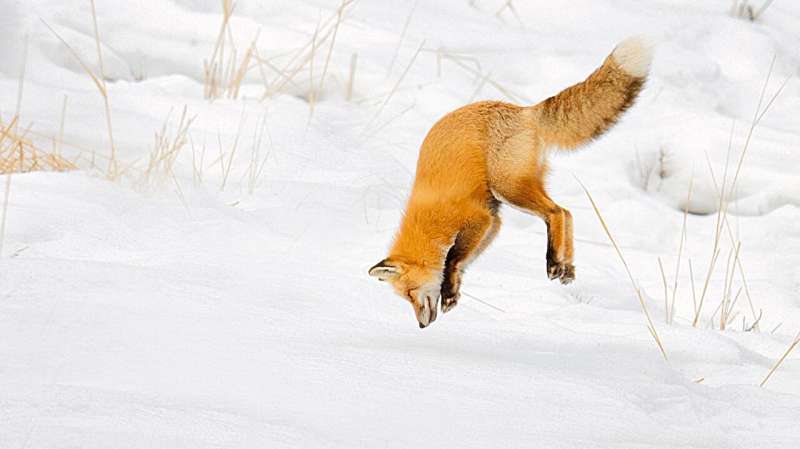This article has been reviewed according to Science X's editorial process and policies. Editors have highlighted the following attributes while ensuring the content's credibility:
fact-checked
peer-reviewed publication
trusted source
proofread
Long snouts protect foxes when they dive headfirst into snow, study finds

When hunting for mice in winter, red and Arctic fox are known to plunge headfirst at speeds of 2–4 meters per second, but their sharp noses reduce the impact force in snow and protect them from injury, according to a new Cornell University study.
The fundamental research sheds light on the biomechanics of the unique hunting behavior (known as mousing), advances our understanding of animal adaptations and offers insights into snow injuries people experience during snowboarding or skiing.
The study appears in the Proceedings of the National Academy of Sciences.
While there have been many studies of water birds and animals such as porpoises and dolphins diving from air into water, interactions between animals and the air-snow interface have not been well-researched. Snow has fluid-like properties when light and fluffy, and solid-like properties when compacted, such as when people make snowballs.
"The fox's sharp snout doesn't significantly compress the snow; it penetrates it without much resistance," said Sunghwan Jung, the paper's corresponding author and professor of biological and environmental engineering. Jisoo Yuk, a doctoral student in Jung's lab, is the paper's first author.
Foxes belong to the dog (Canidae) family, which have evolved long snouts for pack hunting. "Each member of a pack inflicts incremental damage on their prey by biting with their long snouts, which can kill the prey," Jung said. The long snout has the added benefit of facilitating mousing.
On the other hand, members of the cat (Felidae) family are known for their solitary hunting style and have evolved short snouts that can deliver a powerful and lethal bite in a single attempt.
In the study, the authors scanned skulls of red and arctic foxes (from the Canidae family) and lynx and puma skulls (from the Felidae family) at the American Museum of Natural History in Manhattan. They 3D-printed the skulls and attached each to a sensor that measured impact force. The skulls were then dropped into both snow and water, and the researchers entered data into computer models to compare impacts of both.
Jung and colleagues found that the foxes' sharp snouts penetrated the snow with little resistance, minimizing potential tissue damage during a headfirst dive. "Without much compression, in spite of the high-speed impact, the snow behaves like water," Jung said. But the flat Felidae snouts compressed the snow upon impact, creating a large and potentially damaging resistance.
When mousing in snow, the fox's long snout also allows it to reach its prey earlier, as mice are very sensitive to movements in their environment and can quickly escape. Other behavioral studies have shown that prior to pouncing, foxes shake their heads to listen to the rustling sounds of mice or other animals beneath the snow's surface, thereby gauging the depth of the sound source.
"This is a very dangerous process, but we haven't had reports of foxes getting injured," Jung said.
Co-authors include William Bemis, professor of ecology and evolutionary biology and faculty curator of fishes for the Cornell University Museum of Vertebrates.
More information: Jisoo Yuk et al, Effect of skull morphology on fox snow diving, Proceedings of the National Academy of Sciences (2024). DOI: 10.1073/pnas.2321179121
Journal information: Proceedings of the National Academy of Sciences
Provided by Cornell University


















